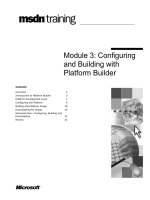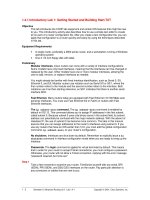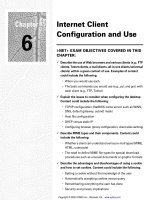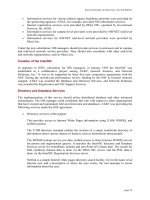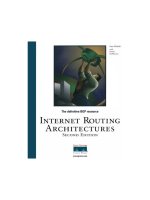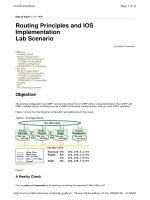UNDERSTANDING INTERNET ROUTING ANOMALIES AND BUILDING ROBUST TRANSPORT LAYER PROTOCOLS docx
Bạn đang xem bản rút gọn của tài liệu. Xem và tải ngay bản đầy đủ của tài liệu tại đây (693.79 KB, 132 trang )
UNDERSTANDING INTERNET ROUTING
ANOMALIES AND BUILDING ROBUST
TRANSPORT LAYER PROTOCOLS
MING ZHANG
A DISSERTATIO N
PRESENTED TO THE FACULTY
OF PRINCETO N UNIVERSI TY
IN CANDIDACY FOR THE DEGREE
OF DOCTOR OF PHILOSOPHY
RECOMMENDED FOR ACCEPTANCE
BY THE DEPARTMENT OF
COMPUTER SCIENCE
SEPTEMB ER 2005
c
Copyright by Ming Zhang, 2005. All rights reserved.
Abstract
As the Internet grows and routing complexity increases, network-level instabilities are be-
coming more and more common. End-to-end communications are especially susceptible
to service disruptions, while diagnosing and mitigating these disruptions are extremely
challenging. In this dissertation, we design and build systems for diagnosing routing
anomalies and improving robustness of end-to-end communications.
The first piece of this work describes PlanetSeer, a novel distributed system for di-
agnosing routing anomalies. PlanetSeer passively monitors traffic in wide-area services,
such as Content Distribution Networks (CDNs) or Peer-to-Peer (P2P) systems, to detect
anomalous behavior. It then coordinates active probes from multiple vantage points to
confirm the anomaly, characterize it, and determine its scope. There are several advan-
tages of this approach: first, we obtain more complete and finer-grained views of routing
anomalies since the wide-area nodes provide geographically-diverse vantage points. Sec-
ond, we incur limited additional measurement cost since most active probes are initiated
when passive monitoring detects oddities. Third, we detect anomalies at a much higher
rate than other researchers have reported since the wide-area services provide large vol-
umes of traffic to sample. Through extensive experimental study in the wide-area net-
work, we demonstrate that PlanetSeer is an effective system for both gaining a better
understanding about routing anomalies and for providing optimization opportunities for
the host service.
To improve the robustness of end-to-end communications during performance anoma-
lies, we design mTCP, a novel transport layer protocol that can minimize the impact of
anomalies using redundant paths. mTCP separates the congestion control for each path
so that it can not only obtain higher throughput but also be more robust to path failures.
mTCP can quickly react to failures, and the recovery process normally takes only several
iii
seconds. We integrate a shared congestion detection mechanism into mTCP that allows
us to suppress paths with shared congestion. This helps alleviate the aggressiveness of
mTCP. We also propose a heuristic to find disjoint paths between pairs of nodes. This can
minimize the chance of concurrent failures and shared congestion. We implement mTCP
on top of an overlay network and evaluate it using both emulations and experiments in
the wide-area network.
iv
Acknowledgments
I have been incredibly fortunate to have had three mentors during the course of my PhD
study. The first one is Professor Randy Wang. I would like to thank him for his guid-
ance, support, and help throughout the years. I consider myself very lucky to have the
chance to work and learn from him. He provided the enthusiasm and encouragement that
I needed to complete this work. The second one is Professor Larry Peterson. He made
himself available for numerous discussions, often started by my dropping by his office
unexpectedly. I always left with a deeper and clearer understanding about those research
problems than I’d had when I arrived. I learned from him that research requires combina-
tion of dedication, confidence, and truly long-term thinking. I am sincerely grateful for
his high standard for research, kindness, and patience. The third one is Professor Vivek
Pai. He provided me invaluable guidance and frequent advice on the PlanetSeer project.
His vigorous approach both to research and to life has greatly shaped and enriched my
view of networking and systems research. I have to thank him for letting me steal an
enormous amount of time and wisdom during the last two years of my PhD study.
I am fortunate to collaborate with Chi Zhang on lots of the work presented in this
thesis. Chi is my friend, lab-mate, as well as apartment-mate. I drew immense inspiration
from him both inside and outside work. He is the best collaborator one could ask for. I
am also grateful to Junwen Lai. The mTCP project would not have been possible without
his help on the user-level TCP implementation.
The second part of my thesis was inspired by my work at ICIR, starting in the summer
of 2001. I thank Dr. Brad Karp for making my visit possible. Later, Brad gave me the
chance to continue collaborating with him at Intel Research Pittsburgh in the summer of
2003. I benefited enormously from the two summers I spent working with him. While at
ICIR, I thank Dr. Sally Floyd for teaching me a lot on TCP related problems. It was a
v
great honor to work with Professor Arvind Krishnamurthy, who provided many vigilant
comments on various algorithms in my work. I am especially grateful to Professor Jen-
nifer Rexford. She always patiently listened to my incoherent thoughts and provided me
amazingly insightful and detailed feedback. I learned a tremendous amount from her on
doing research as well as on writing and presentation.
I am grateful to the PlanetLab staffs for their help with deploying the PlanetSeer
system. Andy Bavier answered me lots of questions on safe raw socket. Marc Fiuczynski
shared with me his extensive experience in vserver. I would like to thank Scott Karlin,
Mark Huang, Aaron Klingaman, Martin Makowiecki, and Steve Muir for their support
and patience. I also thank KyoungSoo Park for his effort in keeping CoDeeN operational
during my experiment.
I would like to thank Professor David Walker and Moses Charikar for serving as
non-readers on my dissertation committee. They gave many valuable comments and
suggestions on my work.
My work was supported in part by NSF grants CNS-0335214 and CNS-0435087, and
DARPA contract F30602-00-2-0561.
I greatly enjoyed my life at Princeton because of the many close friends I had there.
I thank Ding Liu, Chi Zhang, Yaoping Ruan, Fengzhou Zheng, Ting Liu, Wen Xu, Gang
Tan, and Fengyun Cao for their support and encouragement throughput the years. I also
thank my non-Princeton friends, especially Xuehua Shen and Ningning Hu. They made
my life lots of fun.
This thesis is dedicated to my parents. They always gave me love, trust, and pride.
They played the most important role in directing me into pursuing a research career.
vi
Contents
Abstract . . . . . . . . . . . . . . . . . . . . . . . . . . . . . . . . . . . . . . iii
1 Introduction 1
1.1 Why Do Performance Anomalies Occur on the Internet? . . . . . . . . . 3
1.2 Difficulties in Anomaly Diagnosis . . . . . . . . . . . . . . . . . . . . . 5
1.3 Difficulties in Anomaly Mitigation . . . . . . . . . . . . . . . . . . . . . 8
1.4 Overview of the Thesis . . . . . . . . . . . . . . . . . . . . . . . . . . . 9
2 Background and Related Work 12
2.1 Network Testbeds . . . . . . . . . . . . . . . . . . . . . . . . . . . . . . 12
2.2 Intradomain Routing Anomalies . . . . . . . . . . . . . . . . . . . . . . 13
2.3 Interdomain Routing Anomalies . . . . . . . . . . . . . . . . . . . . . . 14
2.4 Traffic Anomalies . . . . . . . . . . . . . . . . . . . . . . . . . . . . . . 15
2.5 End-to-End Failure Measurement . . . . . . . . . . . . . . . . . . . . . . 16
2.6 Link-Layer and Application-Layer Striping . . . . . . . . . . . . . . . . 18
2.7 Transport-Layer Striping . . . . . . . . . . . . . . . . . . . . . . . . . . 18
2.8 Summary . . . . . . . . . . . . . . . . . . . . . . . . . . . . . . . . . . 19
3 PlanetSeer: Internet Path Failure Monitoring and Characterization 21
3.1 Introduction . . . . . . . . . . . . . . . . . . . . . . . . . . . . . . . . . 22
vii
3.2 PlanetSeer Operation . . . . . . . . . . . . . . . . . . . . . . . . . . . . 25
3.2.1 Components . . . . . . . . . . . . . . . . . . . . . . . . . . . . 25
3.2.2 MonD Mechanics . . . . . . . . . . . . . . . . . . . . . . . . . . 26
3.2.3 MonD Behavior . . . . . . . . . . . . . . . . . . . . . . . . . . 27
3.2.4 MonD Flow/Path Statistics . . . . . . . . . . . . . . . . . . . . . 28
3.2.5 ProbeD Operation . . . . . . . . . . . . . . . . . . . . . . . . . 29
3.2.6 ProbeD Mechanics . . . . . . . . . . . . . . . . . . . . . . . . . 31
3.2.7 Path Diversity . . . . . . . . . . . . . . . . . . . . . . . . . . . . 32
3.3 Confirming Anomalies . . . . . . . . . . . . . . . . . . . . . . . . . . . 33
3.3.1 Massaging Traceroute Data . . . . . . . . . . . . . . . . . . . . 33
3.3.2 Final Confirmation . . . . . . . . . . . . . . . . . . . . . . . . . 35
3.4 Loop-Based Anomalies . . . . . . . . . . . . . . . . . . . . . . . . . . . 37
3.4.1 Scope . . . . . . . . . . . . . . . . . . . . . . . . . . . . . . . . 39
3.4.2 Distribution . . . . . . . . . . . . . . . . . . . . . . . . . . . . . 41
3.4.3 End-to-End Effects . . . . . . . . . . . . . . . . . . . . . . . . . 43
3.5 Building a Reference Path . . . . . . . . . . . . . . . . . . . . . . . . . 44
3.6 Classifying Non-loop Anomalies . . . . . . . . . . . . . . . . . . . . . . 48
3.6.1 Path Changes . . . . . . . . . . . . . . . . . . . . . . . . . . . . 49
3.6.2 Path Outage . . . . . . . . . . . . . . . . . . . . . . . . . . . . . 53
3.7 Discussion . . . . . . . . . . . . . . . . . . . . . . . . . . . . . . . . . . 58
3.7.1 Bypassing Anomalies . . . . . . . . . . . . . . . . . . . . . . . 58
3.7.2 Reducing Measurement Overhead . . . . . . . . . . . . . . . . . 60
3.8 Summary . . . . . . . . . . . . . . . . . . . . . . . . . . . . . . . . . . 60
4 mTCP: Robust Transport Layer Protocol Using Redundant Paths 63
viii
4.1 Introduction . . . . . . . . . . . . . . . . . . . . . . . . . . . . . . . . . 63
4.2 Design . . . . . . . . . . . . . . . . . . . . . . . . . . . . . . . . . . . . 67
4.2.1 Transport Layer Protocol . . . . . . . . . . . . . . . . . . . . . . 67
4.2.2 Shared Congestion Detection . . . . . . . . . . . . . . . . . . . . 72
4.2.3 Path Selection . . . . . . . . . . . . . . . . . . . . . . . . . . . . 77
4.2.4 Path Management . . . . . . . . . . . . . . . . . . . . . . . . . . 80
4.2.5 Path Failure Detection and Recovery . . . . . . . . . . . . . . . . 81
4.3 Implementation . . . . . . . . . . . . . . . . . . . . . . . . . . . . . . . 83
4.4 Evaluation . . . . . . . . . . . . . . . . . . . . . . . . . . . . . . . . . . 84
4.4.1 Methodology . . . . . . . . . . . . . . . . . . . . . . . . . . . . 84
4.4.2 Utilizing Multiple Independent Paths . . . . . . . . . . . . . . . 85
4.4.3 Recovering from Partial Path Failures . . . . . . . . . . . . . . . 90
4.4.4 Detecting Shared Congestion . . . . . . . . . . . . . . . . . . . . 92
4.4.5 Alleviating Aggressiveness with Path Suppression . . . . . . . . 97
4.4.6 Suppressing Bad Paths . . . . . . . . . . . . . . . . . . . . . . . 98
4.4.7 Comparing with Single-Path Flows . . . . . . . . . . . . . . . . 99
4.5 Summary . . . . . . . . . . . . . . . . . . . . . . . . . . . . . . . . . . 103
5 Conclusion and Future Work 104
5.1 Summary of the Dissertation . . . . . . . . . . . . . . . . . . . . . . . . 104
5.1.1 Internet Path Failure Monitoring and Characterization . . . . . . 105
5.1.2 Robust Transport Layer Protocol Using Redundant Paths . . . . . 106
5.2 Future Work . . . . . . . . . . . . . . . . . . . . . . . . . . . . . . . . . 107
5.2.1 Debugging Routing Anomalies . . . . . . . . . . . . . . . . . . . 107
5.2.2 Debugging Non-Routing Anomalies . . . . . . . . . . . . . . . . 109
ix
5.2.3 Internet Weather Service . . . . . . . . . . . . . . . . . . . . . . 110
x
List of Figures
1.1 The Internet consists of many ASes . . . . . . . . . . . . . . . . . . . . . . 2
1.2 Routing anomaly is often propagated . . . . . . . . . . . . . . . . . . . . . 6
3.1 Percentage of loops and traffic in each tier . . . . . . . . . . . . . . . . . . . 41
3.2 CDF of loss rates preceding the loop anomalies . . . . . . . . . . . . . . . . 43
3.3 CDF of RTTs preceding the loop anomalies vs. under normal conditions . . . . 44
3.4 Narrowing the scope of path change . . . . . . . . . . . . . . . . . . . . . . 49
3.5 Scope of path changes and forward outages in number of hops . . . . . . . . . 49
3.6 Distance of path changes and forward outages to the end hosts in number of hops 50
3.7 Percentage of forward anomalies and traffic in each tier . . . . . . . . . . . . 52
3.8 Narrowing the scope of forward outage . . . . . . . . . . . . . . . . . . . . 54
3.9 CDF of loss rates preceding path changes and forward outages . . . . . . . . . 56
3.10 CDF of RTTs preceding path changes and forward outages vs. under normal
conditions . . . . . . . . . . . . . . . . . . . . . . . . . . . . . . . . . . 58
3.11 CDF of latency ratio of overlay paths to direct paths . . . . . . . . . . . . . . 59
3.12 CDF of number of path examined before finding the intercept path . . . . . . . 61
4.1 CDF of number of disjoint paths between node-pairs . . . . . . . . . . . 79
4.2 Topology of multiple independent paths on Emulab . . . . . . . . . . . . 85
xi
4.3 Throughput of mTCP flows with combined or separate congestion control
as number of paths increases from 1 to 5 . . . . . . . . . . . . . . . . . . 86
4.4 Throughput percentage of individual flows . . . . . . . . . . . . . . . . . 88
4.5 cwnd of primary path, primary path fails . . . . . . . . . . . . . . . . . . 89
4.6 cwnd of auxiliary path, primary path fails . . . . . . . . . . . . . . . . . 89
4.7 Two independent paths used in shared congestion detection . . . . . . . . 91
4.8 Two paths that completely share congestion . . . . . . . . . . . . . . . . 91
4.9 On two paths with shared congestion, ratio increases as interval increases 93
4.10 On two independent paths, ratio decreases faster when interval is smaller 93
4.11 All paths share congestion in this topology . . . . . . . . . . . . . . . . . 97
4.12 MP
1
flows are less aggressive than other mTCP flows . . . . . . . . . . . 98
4.13 Path suppression helps avoid using bad paths. . . . . . . . . . . . . . . . 99
4.14 mTCP flows achieve better throughput than single-path flows . . . . . . . 101
4.15 Throughput of mTCP and single-path flows is comparable . . . . . . . . 102
5.1 Locating the origin of AS-path change . . . . . . . . . . . . . . . . . . . . . 108
xii
List of Tables
3.1 Groups of the probing sites . . . . . . . . . . . . . . . . . . . . . . . . . . 31
3.2 Path diversity . . . . . . . . . . . . . . . . . . . . . . . . . . . . . . . . . 33
3.3 Breakdown of anomalies reported by MonD . . . . . . . . . . . . . . . . 35
3.4 Breakdown of reported anomalies using the four confirmation conditions . 36
3.5 Summarized breakdown of 21565 loop anomalies. Some counts less than 100%
because some ASes are not in the AS hierarchy mapping. . . . . . . . . . . . . 39
3.6 Number of hops in loops, as % of loops . . . . . . . . . . . . . . . . . . 40
3.7 Non-loop anomalies breakdown . . . . . . . . . . . . . . . . . . . . . . 47
3.8 Summary of path change and forward outage. Some counts exceed 100%
due to multiple classification. . . . . . . . . . . . . . . . . . . . . . . . . 53
3.9 Breakdown of reasons for inferring forward outage . . . . . . . . . . . . . . . 55
4.1 Independent paths between Princeton and Berkeley nodes on PlanetLab. . 87
4.2 Paths used in the failure recovery experiment. . . . . . . . . . . . . . . . 89
4.3 Shared congestion detection for independent paths. . . . . . . . . . . . . 95
4.4 Paths with shared congestion on PlanetLab. . . . . . . . . . . . . . . . . 96
4.5 Shared congestion detection for correlated flows. . . . . . . . . . . . . . 96
4.6 The 10 endhosts used in the experiments that compare mTCP with single-
path flows. . . . . . . . . . . . . . . . . . . . . . . . . . . . . . . . . . . 100
xiii
Chapter 1
Introduction
As the Internet has experienced exponential growth in recent years, so does its complex-
ity. The increasing complexity can potentially introduce more network-level instabilities.
Today, the Internet consists of roughly 20,000 Autonomous Systems (ASes) [32], where
each AS represents a single administrative entity. As shown in Figure 1.1, to go from
one endpoint to another, packets have to traverse a number of ASes. Ideally, the pack-
ets should be delivered both reliably and efficiently through the network. However, in
reality, the network paths may not be perfect. One pathological event occurring within
a single AS could affect many ASes and a large number of network paths through those
ASes. During such periods, users will perceive performance degradation. Our goal is to
improve the performance and robustness of end-to-end communications on the Internet.
In this dissertation, we focus on the network performance anomalies, which are broadly
defined as any pathological events occurring in the network that cause end-to-end perfor-
mance degradation.
We study performance anomalies from two perspectives. In the first part of this the-
sis, we aim to understand the characteristics of the anomalies. More specifically, we
1
AS3
AS2
AS1
AS4
AS7
AS5
AS6
Client
Web Server
Figure 1.1: The Internet consists of many ASes
investigate how to detect and diagnose the anomalies, how to estimate their locations and
scopes, and how to quantify their effects on the end-to-end performance. These types of
information are very important. On the one hand, knowing where the anomalies occur
will improve the accountability of the Internet. A customer may use this information to
select good service providers (ISPs). Similarly, an ISP may use this information to se-
lect good peering ISPs. In addition, if two entities have service level agreements (SLAs)
with each other, they may obtain compensations for violating these agreements. On the
other hand, knowing why the anomalies occur will help the network operators to fix the
problems quickly and to prevent the similar problems from occurring in the future.
Although understanding the characteristics and origins of performance anomalies can
help us improve the long-term stability of the Internet, we are still going to encounter
anomalies frequently in the foreseeable future. When an anomaly does occur, it is desir-
able for end users to be able to bypass the anomaly as quickly as possible. In the second
part of this thesis, we describe a novel transport layer protocol that can minimize the im-
2
pact of anomalies by taking advantage of redundant paths on the Internet. Today, TCP
is the dominant transport layer protocol for end-to-end communications. TCP only uses
a single network path between two endpoints. Should any congestion or failure occur
on that path, TCP’s performance will be significantly reduced. Recent work on Internet
measurement and overlay networks has shown that there often exist multiple paths be-
tween pairs of hosts [78]. Using these redundant paths, we can not only aggregate the
bandwidth of multiple paths in parallel but also enhance the robustness of end-to-end
communications during anomalies.
In Section 1.1, we first briefly explain why anomalies occur on the Internet and how
they affect end-to-end performance. Then in Section 1.2 and 1.3, we explain why it
is difficult to detect, diagnose and mitigate anomalies. At the end of this chapter in
Section 1.4, we provide an overview of this dissertation.
1.1 Why Do Performance Anomalies Occur on the Inter-
net?
Although the Internet is designed to be self-healing, users often experience performance
degradation. For instance, they may find certain websites are unreachable or their network
speed is very slow. These problems may be caused by various pathological events that
occur in the network.
Routing instability is one of the major sources of performance anomalies. Routing
protocols are responsible for discovering the paths to reach any destination on the In-
ternet. Routing protocols can be classified into interdomain and intradomain protocols.
Intradomain protocols (IGP), such as OSPF[44] or IS-IS[20], are responsible for dis-
3
seminating reachability information within an AS. Interdomain protocols (EGP), such as
BGP[75], maintain the reachability information among all the ASes.
Routing instabilities may arise when routing protocols are adapting to topological or
policy changes. Inside an AS, link outages often stem from maintenance, power outages,
and hardware failures [53]. When an outage occurs, routing protocols may try to bypass
the failure using alternate paths. This, in turn, will lead to route changes. Sometimes,
route changes may also be caused by traffic engineering inside a network [30, 50]. At
the AS-level, outages may arise due to peering link failures or eBGP session resets [91].
These outages can lead to AS-path changes. In addition, since BGP incorporates policies
into route selection process, AS-level route changes may be triggered by policy changes
as well [75].
Besides route changes and outages, routing instabilities can often lead to routing
loops. When a routing instability occurs, each router needs to propagate the latest reacha-
bility information to routers within the same AS or in other ASes through routing updates.
During this process, loops may evolve because different routers may have inconsistent
routing states. The convergence time of the propagation process itself can be highly
varied. IGPs usually converge within several hundred milliseconds [79] to several sec-
onds [42]. In contrast, it may take tens of minutes for BGP routers in different ASes to
reach a consistent view on the network topology [52].
Due to the complexity of routing protocols, routing instabilities can also be caused
by misconfigurations. A recent study shows that 3 in 4 new prefix advertisements re-
sult from BGP misconfigurations [61]. In an earlier study, Labovitz, Malan and Jahanian
find that 99% of BGP updates are pathological and do not reflect network topological
changes[54]. These BGP misconfigurations can cause various routing problems, such as
4
routing loops [22, 26], invalid routes [61], contract violations [27], and persistent oscilla-
tions [12, 34, 89].
Another major source of performance anomalies is congestion. Congestion arises
when the packet arrival rate of a link exceeds the link capacity. It is often caused by flash
crowds, distributed denial of service (DDoS) attacks, worm propagations, or sometimes
even routing instabilities [86]. When a link becomes congested, it may have to delay or
drop packets. This will impose negative effects on flows that are traversing that link. For
instance, TCP’s throughput is inversely proportional both to the round trip time (RTT) and
to the square root of loss rate [70]. When the loss rate or RTT increases, the throughput of
TCP will decrease. When the loss rate exceeds 30%, TCP becomes essentially unusable
since it spends most time in timeouts [70].
1.2 Difficulties in Anomaly Diagnosis
Although performance anomalies occur quite frequently on the Internet, diagnosing these
anomalies is nontrivial. This is because the Internet is not owned by a single administra-
tive entity but instead consists of many autonomous systems (ASes). Each AS is operated
by a network service provider (ISP) and has its own routing policy. The routing informa-
tion shared between two ASes is heavily filtered and aggregated using BGP [75]. While
this allows the Internet to scale to thousands of networks, it makes anomaly diagnosis
extremely challenging.
As we described in the beginning of Section 1, the network path between two end-
points usually traverses multiple ASes and routers. When an anomaly arises, any inter-
mediate component in that path can introduce the problem. Although tools like ping and
5
AS3
AS2
AS1
AS4
AS5
AS6
Client
Web Server
Figure 1.2: Routing anomaly is often propagated
traceroute exist for diagnosing network problems, determining the origins of anomalies
is exceptionally difficult for several reasons:
Anomaly origin may differ from anomaly appearance. Routing protocols, such as
BGP, OSPF, and IS-IS, may propagate reachability information to divert traffic away from
failed components. When a traceroute stops at a hop, it is often the case that the router
has received a routing update to withdraw that path, leaving no route to the destination.
For example in Figure 1.2, the client traverses the AS path “6 5 4 3 2 1” to reach the web
server. Suppose there is a link outage between AS2 and AS3 that makes the web server
unreachable from AS3. This unreachability information will be propagated from AS3 to
AS4, AS5, and AS6. Although the traceroute from the client will stop at AS6, AS6 is
actually far away from the origin of the failure.
Anomaly information may be abstracted. The Internet consists of many ASes and
each AS manages its own network independently. An AS will hide various internal in-
6
formation from other ASes for scalability reasons. In addition, since ASes are often
competing with each other, they are unwilling to share sensitive information, such as
their traffic, topology, and policy. As a result, when an AS observes an anomaly, it may
not have enough detailed information to either pinpoint or troubleshoot the anomaly. For
example in Figure 1.2, when AS6 loses the route to the web server, it can hardly tell
whether the problem occurs in AS1, 2, 3, 4, or 5.
Anomaly durations are highly varied. Some anomalies, like routing loops, can last
for days. Others may persist for less than a minute. This high variability makes it hard to
diagnose anomalies and react in time.
Network paths are often asymmetric. Because BGP is a policy-based routing proto-
col, this may lead to asymmetric paths, which means the sequence of ASes visited by the
routes for the two directions of a path differ. Paxson observed that 30% of node pairs
have different forward and reverse paths which visit at least one different AS [71]. Since
traceroute only maps the forward path, it is hard to infer whether the forward or reverse
path is at fault without cooperation from the destination.
For the above reasons, to diagnose anomalies, we have to collect anomaly-related
data from many locations. Historically, few sites had enough network coverage to pro-
vide such fine-grained and complete information. The advent of wide-area network
testbeds like PlanetLab [74] has made it possible to diagnose anomalies from multiple
geographically-diverse vantage points. In Chapter 3, we will introduce PlanetSeer, a
novel diagnostic system that can take advantage of the wide coverage of PlanetLab [94].
We will describe in detail how PlanetSeer combines passive monitoring with widely-
distributed probing machinery to detect and isolate routing anomalies on the Internet.
7
1.3 Difficulties in Anomaly Mitigation
As we have mentioned before, BGP is the de-facto interdomain routing protocol on the
Internet today. BGP is a policy-based protocol which computes routes conforming to
commercial relationships between ASes. This may lead to suboptimal routing decision
for end-to-end communications [5]. For instance, Spring, Mahajan, and Anderson show
that current peering policies cause the latency of over 30% of the paths to be longer
than the shortest available paths [82]. In addition, because BGP has to scale to a large
number of networks, it adopts various mechanisms to hide detailed information and damp
routing updates. Although this reduces the chance of routing oscillations, it makes BGP
less responsive to failures. Sometimes, it takes many minutes for BGP to converge to a
consistent state after failures [52]. The end-to-end service disruptions could last for tens
of minutes or more [65].
More recently, application-layer overlay routing has been proposed as a remedy to
this problem. Overlay routing can recover from performance degradation within a shorter
period of time than the wide-area routing protocols [5]. In an overlay routing system, the
participating nodes periodically probe each other to monitor the performance of the paths
between them. When an anomaly is detected on the direct Internet path between a pair of
nodes, the system will try to bypass the anomaly by choosing a good overlay path through
one or more intermediate nodes.
While overlay routing can circumvent performance degradation more quickly, its ef-
fectiveness to a large extent depends on its active probing mechanism. We use Resilient
Overlay Networks (RON) [5], a representative overlay routing system, to exemplify these
problems. First, when an anomaly occurs, how fast RON can recover from the anomaly
is determined by its probing rate. In RON, the participating nodes probe each other every
8
3 seconds during the anomalous period. Correspondingly, its mean outage detection time
is 19 seconds. However, the probing overhead of this approach is O(n
2
), where n is the
total number of nodes. When n becomes large, it is difficult to maintain low measurement
overhead while still achieving short recovery time.
Second, RON estimates the available bandwidth of the monitored paths using ac-
tive probing. When an anomaly is detected, it chooses a good alternate path based on
the estimated bandwidth. However, the state-of-the-art available bandwidth estimation
tools need to inject a fair amount of probing packets to obtain reasonably accurate esti-
mates [46, 40, 3]. For scalability reasons, RON uses a much more lightweight probing
mechanism. This may lead to inaccurate bandwidth estimates under many circumstances,
which in turn impairs its routing decisions.
To overcome these problems, we design mTCP, a novel transport layer protocol that
can utilize multiple paths in parallel [93]. By using more than one paths, mTCP can
recover from performance anomalies very quickly. Our approach incurs little measure-
ment overhead, since mTCP can accurately estimate the available bandwidth of multiple
paths by passively monitoring the traffic on those paths. We will describe more on this in
Chapter 4.
1.4 Overview of the Thesis
We now give an overview of this dissertation. In Chapter 2, we describe the related work
in this area and provide a background for our work. We will first introduce the network
testbeds that are used for evaluating our systems. We then go through the recent work
on studying performance anomaly on the Internet. Based on their methodologies, we
classify them into intra- and inter-domain routing anomalies, traffic anomalies, and end-
9
to-end measurements. At the end of Chapter 2, we will discuss the research efforts that
improve the end-to-end performance using striping at the link-layer, application-layer and
transport-layer.
Chapter 3 focuses on PlanetSeer, a large-scale distributed system for routing anomaly
detection and diagnosis. We first describe the components and mechanism of PlanetSeer,
including how to detect suspicious routing events by passively observing the traffic gen-
erated by wide-area services and how to coordinate multiple nodes to actively probe these
events. We then analyze the anomaly data that is collected during a 3-month period in
2004. We describe our techniques for confirming the routing anomalies, classifying them,
and characterizing their scopes, locations, and end-to-end effects. In the end, we quantify
the effectiveness of overlay routing in bypassing path failures.
Chapter 4 presents mTCP, a novel transport layer protocol that is robust to perfor-
mance anomaly. mTCP differs from traditional transport layer protocols in that it can
use more than one paths in parallel. It has four major components: 1) new congestion
control for aggregating bandwidth on multiple paths, 2) shared congestion detection and
suppression for alleviating the aggressiveness of mTCP, 3) failure detection and recovery
for quickly reacting to performance anomaly, and 4) path selection for minimizing the
chance of concurrent failures and shared congestion. mTCP has been implemented as a
user-level application running on top of overlay networks. We use experiments on both
local-area and wide-area network testbeds to demonstrate its effectiveness.
Chapter 5 concludes with a summary of this dissertation and our vision for future
work. We have made two main contributions in this work. First, we demonstrate that
it is possible to build a distributed system for detecting and isolating routing anomalies
with high accuracy. Second, we can dramatically improve the robustness of end-to-end
communications using redundant paths. We are going to continue our research in sev-
10
eral directions. First, we plan to extend our system by studying performance anomalies
caused by non-routing problems. Second, We plan to investigate new ways to improve
the accuracy of routing anomaly diagnosis and to reduce measurement overhead. Finally,
we plan to build a network weather service that can continuously monitor the health of
the Internet.
11
Chapter 2
Background and Related Work
In this chapter, we provide a background for our work and give an overview of the re-
lated work in this area. There have been many research efforts on studying anomalies
in the Internet and designing robust network protocols. We will focus on those that are
most relevant and discuss their difference from our approaches. We first briefly introduce
the network testbeds used for our experiments and evaluations. We then turn to the re-
cent studies on network anomalies, which include interdomain and intradomain routing
anomalies, traffic anomalies, and end-to-end failure measurements. In the end, we discuss
the research efforts that use striping techniques to improve performance and robustness.
Based on the network layer where the striping techniques are applied, we classify them
into link-layer, transport-layer, and application-layer striping.
2.1 Network Testbeds
We evaluate our systems with both emulations and real-world deployment. The emu-
lations are conducted on Emulab [24], a time- and space-shared network emulator. It
12
